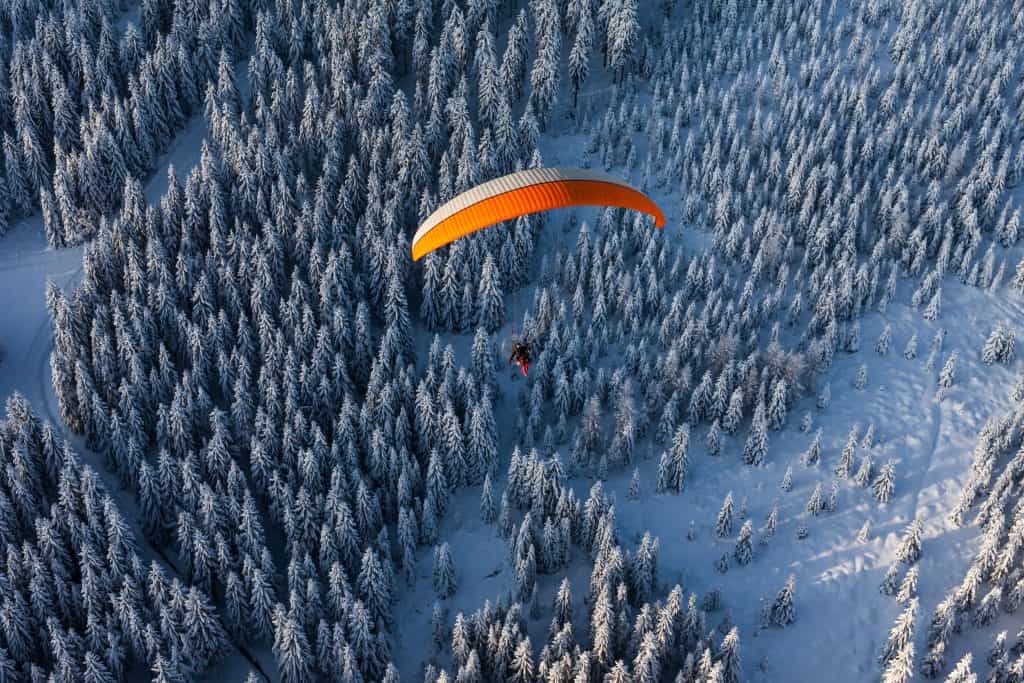
Paramotoring is an incredibly fun and exciting sport to take part in. Flying around open fields and up in the wide open sky is a feeling like no other. Many people like to paramotor during the summer, but can you fly your paramotor in the winter time?
So, can you fly a paramotor in the winter? You can fly your paramotor during the wintertime, though it will be different than summer flying in a few key ways. There is a lesser degree of thermal generation, precipitation reacts differently with your wing, and you need to be careful about the altitudes and speeds at which you fly.
Let’s take a closer look at the ways that the season of winter has an effect on paramotoring, and discuss different ways to combat some of the negative changes.
Change in Thermal Generation
Thermals are an important part of paramotoring because thermals can collapse paramotor wings and potentially cause issues with paramotoring.
In order to understand one of the biggest differences between paramotoring in winter and paramotoring in the other seasons, we have to have an understanding of how thermals work, how they are formed, and what they do to paramotors.
What are Thermals, and How do They Work?
Thermals are pockets of warmer air that rise up through the atmosphere. These pockets of air are the method by which paragliders, hang gliders, and at times
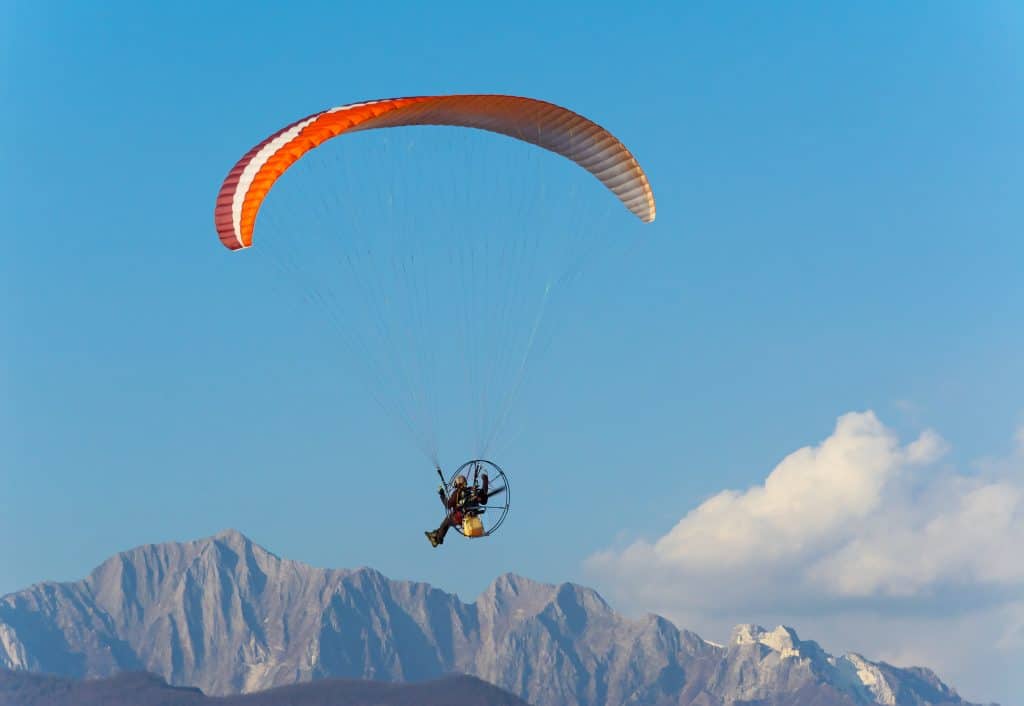
The warmer pocket of air rises because it is surrounded by cooler air, and there is pressure for the warm air to go up because of this.
Getting into and staying in a thermal takes skill, and is one of the reasons that paragliding is so tough to get into. Paramotorists however, unlike paragliders, do not really need thermals as we have a motor to help us gain elevation.
Thermals tend to be more of a hindrance to paramotors. The wind is turbulent around them, and they tend to do more harm than good unless you are looking for and expecting to find these thermals.
How Thermals are Formed
Thermals are formed when the sun warms up a pocket of air. This warming is usually done by the ground absorbing sunlight, and the ground warming up the air by convection.
The places that the thermals form depends largely on where the sunlight is hitting the earth, and if the earth is capable of heating up in that spot.
Some things that might keep the ground from heating up and thermals begin created are things like snow, cloud cover, and flowing or moving water.
Thermals and Paramotors
Paramotors and Paragliders are the same on the surface, but the way that they are flown is meant to be very different.
Paragliders interact with thermals almost constantly, with paragliders traveling hours to different thermal hot spots to fly around. Paramotors don’t need these hotspots, as they can gain elevation with their engines.
When Paramotorsists talk about thermals, they only sometimes talk about them with much fondness. Thermals cause turbulent winds, which is a paramotorist’s worst nightmare. They can collapse your wing, and give you trouble.
Paragliders are flown to thrive in environments with thermals, and paramotors easily can be as well, but the addition of an engine makes paramotors interactions with thermals unnecessary and redundant.
Differences Between Winter and Other Seasons
Winter is different from other seasons in thermalling because
One might think that thermalling would be less common because the air is cold, and has trouble warming up. However, this is not how thermals work.
“Warmer” is a relative term, and so long as the pocket of air that the sun is warming is warmer than the air around it, it can be well below freezing and there can still be thermals.
No, the thing that makes thermalling less common in the winter time is that the sun is unable to heat the ground as effectively. The sunlight is reflected off of the snow that is on the ground, and with the ground not being able to heat up, no thermals are formed.
It’s the same idea for cloud cover. In the winter time, clouds often cover the sky and they block the sunlight from reaching the ground. This, once again, keeps thermals from being generated.
There is a rule of thumb in paramotoring that you should not fly at midday. This is because it’s when thermals are the strongest. However, in the winter time, thermals (though more likely to appear at midday) are not as big an issue as other seasons.
It’s alright to fly in the middle of the day, but for minimal thermal encounters, fly in the morning or afternoon.
Snowfall and Your Wing: Can You Stall Out in the Winter?
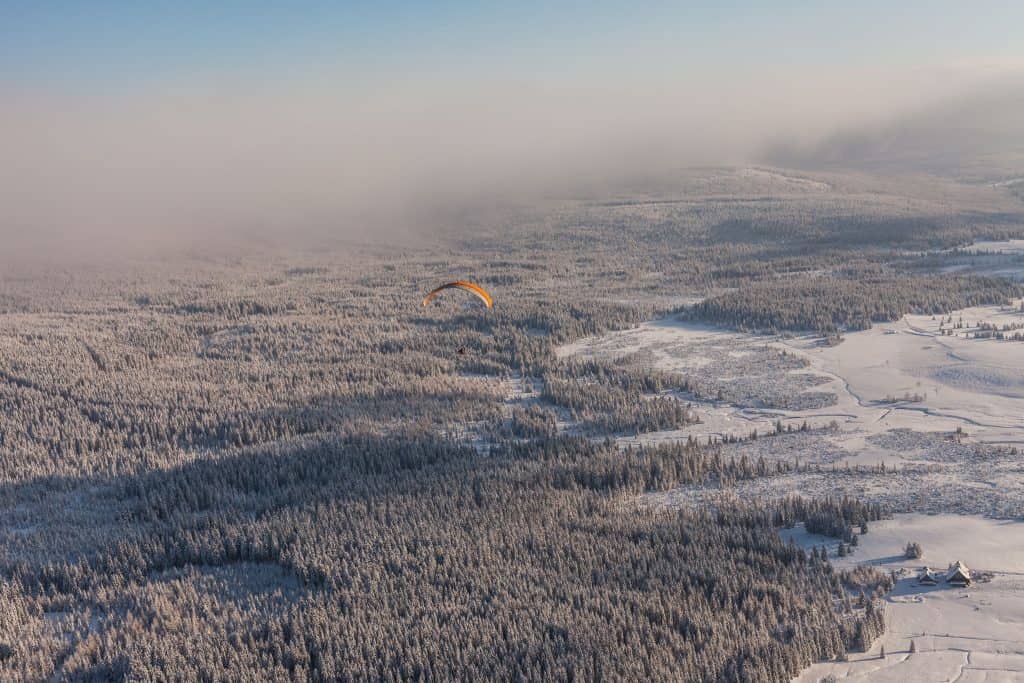
In the summer, spring, and fall seasons, precipitation brings with it the
Flying in Precipitation and the Possibility of Stalling Out
First, we need to understand the way that the stall’s work in the other seasons to compare what can happen to your wing in the winter time. A collapse can happen to a wing when the angle of attack of the wing lowers below the flow of the wind.
When a wing stalls out, it means that is has lost momentum, and paramotors are designed so that that momentum will return, and it will return violently if necessary.
When momentum returns to a stalled wing, it can dip the angle of attack below the angle of the flow of wind. This results in a collapse.
When a wing is soaked, the chances to stall are increased as the wing not only has more weight on it, but the wing with its damp fabric has the chance to disrupt itself and cause a collapse that way.
Disaster is far more likely when flying with a damp or wet wing, and if it starts raining, every paramotorist with half a brain knows that it’s time to land and get indoors.
Can Snow Stall Your Wing?
We know that rain, sleet, and other wet forms of precipitation can cause troubles for you, but what about snow? It’s shouldn’t be too much of an issue right? Well, that depends on the temperature.
Let’s picture two difference scenarios:
Scenario 1: “You are flying your paramotor over the forests of Northern New York. It’s a cold, overcast day, and the sun is nowhere in sight. It’s wintertime, and it feels like it. The cold weather today, accompanied by the snow falling around you gives you a mood of stoic coldness.
You take a look up at your wing and realize that the snowflakes are clinging to your wing, but aren’t melting because of how cold it is. You’re thankful that you get the chance to enjoy this quiet scene for a moment.”
Scenario 2: “You are flying your paramotor over the forests of Northern New York. It’s later that same day with a somewhat clear sky and a bright dazzling sun.
It’s winter time, but it sure doesn’t feel like it. The warm weather feels great, and you’re grinning to yourself, feeling the sun on your skin for the first time in ages.
You look up and notice that there are no snowflakes clinging to your wing anymore. You keep smiling until you try to turn and realize that the snowflakes that were on your parachute have melted from the warm air, and are now slowing you down and causing you trouble.
You quickly land and decide to pack up after a long day of paramotoring, because you know that a damp wing is nothing to ignore.”
Snow itself will have major trouble stalling your wing, but melted snow dampening the wing will be an issue. Be sure to look out for that, and consider purchasing hydrophobic wings to help yourself avoid a
Launching/Relaunching in the Wintertime
Here are a few quick tips and tricks to launching a paramotor in the winter time.
Trouble Launching: Anyone who tries to fly paramotors in the winter time will quickly run into the problem of not being able to move very fast on the ground. This will cause some trouble for launching, as you typically need a good running head start before you can properly take off.
One trick to get past this initial need for speed is to take a sled and ride it as you gain speed. Stand up on your knees, and grip the sled with your legs/knees somehow.
Let the sled go as you use the wing to lift yourself up, and have someone on the ground be there to collect it for you.
On the other hand, it’s actually quite interesting taking the sled with you down a mountain or hill and being able to just fly back up to the top once you’ve reached the bottom.
Tying the certain sleds to your legs can be a wild, but a
Trouble Relaunching: Sometimes, pilots will come in for a landing in a snowy field, and forget to check their wing before they try to take off again a moment later. Snow can get into the wing, especially with the motor blowing snow back there.
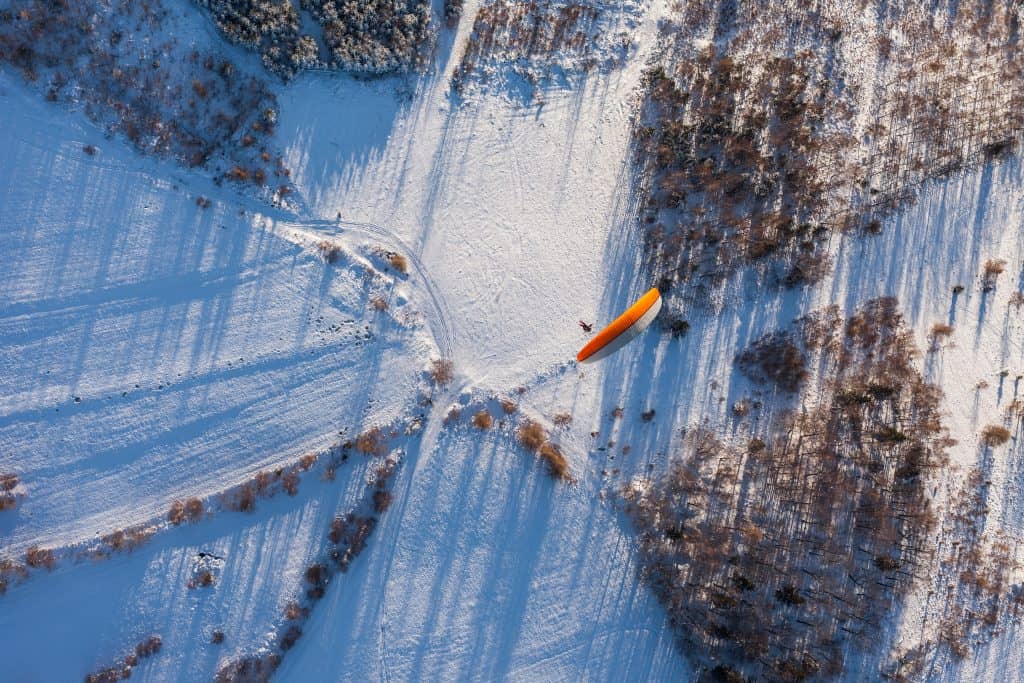
This can cause trouble for the pilot trying to leave. Be sure that you check the wing first before just assuming that it’s clear and that you won’t be trying to launch with snow in the wing.
Altitude and Speed: Your Temperature While Flying in the Winter
In the winter time, the air is colder by default. There are issues with flying that you don’t encounter as severely in other seasons that you encounter quite intensely in the winter.
Issues such as the
Temperature Change in Altitude
It’s well known in the paramotoring community that the higher up you fly, the colder it gets. Flying at 5k feet in normal circumstances is something that most pilots don’t want to handle. In the winter time, it’s even worse.
Typically, you will be warmer if you fly nearer to the earth. If you want to keep your flights warm, keep it tight to the ground, within 1,000 feet even.
It’s important to stay warm while paramotoring in the winter, even if it means sacrificing some altitude, it’s worth it for you to keep your body and mind sharp and focused on flying.
How Speed Affects Your Temperature
The speed that you fly a paramotor at has a direct relation to how much wind is hitting you. If this wind is cold, like it usually is in the winter time, it will be a problem.
Unless you have the proper equipment, flying quickly in the wintertime is likely to blow all the warmth out of you and make your flying experience miserable. Stay warm at all costs, even if that means that you have to fly a little slower than usual.
Strategies for Staying Warm in the Sky
To stay warm in the sky, keep yourself from traveling too fast, and from traveling too high. Limiting yourself in these things will help you to retain most of your body heat, and keep yourself warm.
In addition to this, you can keep hand warmers inside a compartment on your paramotor, and pull them out when you need them.
Keeping spare clothing inside compartments is a good idea as well. You never know what you’ll accidentally drop from 2,000 ft in the air, and never see again. It’s good to have a spare set of gloves and a hat at least.
Suggested Flying Gear for Wintertime Paramotoring
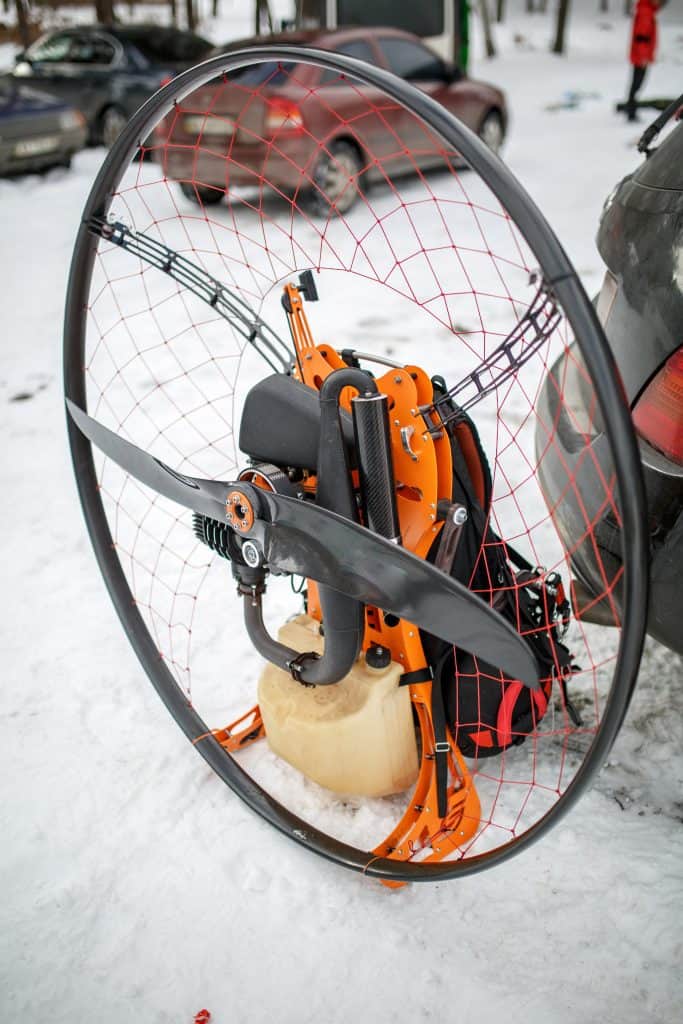
We’ve talked a bit about the spare clothing you may decide to take with you, but what about the clothing you should wear in winter flying generally?
Standard Winter Gear
Winter gear is always a safe bet when paramotoring, but it’s especially fitting in the winter. Snow pants are a fabulous choice, and ski masks and a great way to go as well. A heavy winter coat goes a long way.
My personal motto for dressing warmly in the winter season though is “Layers, layers, layers!”. Wearing multiple layers of clothes, even stuff like your everyday clothing is a great idea. It helps trap your body heat and keeps it close to you.
Compression Undergarments
Compression Undergarments are incredibly underrated. They are comfortable, form-fitting, and help with blood flow.
Keeping your blood flowing smoothly is important at those high G’s, and it’s never more important than when doing acro at only a few thousand feet above the ground to keep yourself awake and aware.
Compression undergarments and their added benefits of increased blood flow also warm up the body.
Windbreakers
Windbreakers are a must have when flying in the winter. The wind can blow any warmth you had right out of you. Windbreakers break up the wind with their tight mesh fabric and let you keep the warmth that you have on you already.
Paramotor Gloves
Any old gloves are better than nothing, but what you need are some brand new paramotoring gloves.
My suggestion is the “Freestyle Hot 5 Heated Paramotoring Gloves” product sold on High Adventure Paragliding. These gloves have heat sources which use energy efficient metal fiber heating elements which are flexible and safe to wear. With heat on both sides of the hand, this is a fabulous choice for paramotoring gloves.
The best possible set up I can imagine is to wear compression undergarments with layers of normal wear on top of that. Then adding in snow pants, a heavy winter coat, and a windbreaker on the outside should keep you snug as a bug on your flight.
Wearing paramotor gloves, as well as layers of socks will keep your extremities warm as well, and it’s up to you whether you’d like to wear a ski mask or not, but I’d suggest it.
What you should under no circumstance ever do is wear a scarf. Scarfs can get caught in the blades of the paramotor fan, and can potentially break your neck depending on the scarf. Don’t wear scarfs.
Wintertime
Winter is a season with its strengths and weaknesses for paramotoring. For one it’s safer than other seasons as far as
It’s my hope that this article will be able to help you with your winter excursions and that you will have a fabulous time paramotoring, whatever season it may be!
Related Questions
What is the best time of day to Fly Paramotors? The best time of day for riding paramotors is in the morning or afternoon when the wind is usually the calmest. After midday, thermals weaken and become much more manageable. Don’t fly at midday unless there is something keeping thermals from forming, such as overcast weather, or snow on the ground.
How High Can a Paramotor Fly? It’s possible to fly them to 15,000 feet, but the air is thin up there and it’s extremely dangerous. Most paramotor flights are around 1,000 feet up. It’s generally safer to fly high than low. When flying closer to the ground, you don’t have time to react to a problem before hitting the ground.
How Long Does it Take to Learn to Paramotor? Paramotoring school lasts only about 1-2 weeks, but by the end of it you should be able to maintain a wing, maintain a motor, control the wing on the ground, and go for a short flight. Any additional training would just be a
